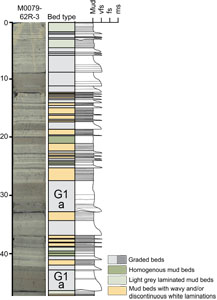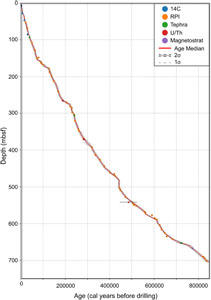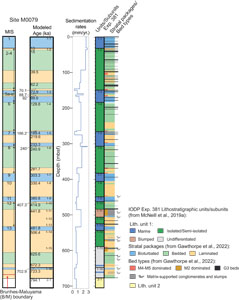McNeill, L.C., Shillington, D.J., Carter, G.D.O., and the Expedition 381 Participants
Proceedings of the International Ocean Discovery Program Volume 381
publications.iodp.org
https://doi.org/10.14379/iodp.proc.381.201.2025
Data report: age-depth model of the Corinth synrift sequence, Site M0079, IODP Expedition 3811
S. Pechlivanidou,2 M. Muravchik,3 R. L. Gawthorpe,2 G. De Gelder,2 S. A. Oflaz,2 R. E. LI. Collier,2 J. Gillespie,2 M. L. Machlus,2 M. Maffione,2 E. Herrero-Bervera,2 M. Ford,2 N. Fabregas,2 S. Sergiou,2 M. Geraga,2 M. Phillips,2 J. Brendryen,3 L. C. McNeill,2 D. J. Shillington,2 C. Seibert,4, 5 and the Expedition 381 Participants2
1 Pechlivanidou, S., Muravchik, M., Gawthorpe, R.L., De Gelder, G., Oflaz, S.A., Collier, R.E.LI., Gillespie, J., Machlus, M.L., Maffione, M., Herrero-Bervera, E., Ford, M., Fabregas, N., Sergiou, S., Geraga, M., Phillips, M., Brendryen, J., McNeill, L.C., Shillington, D.J., Seibert, C., and the Expedition 381 Participants, 2025. Data report: age-depth model of the Corinth synrift sequence, Site M0079, IODP Expedition 381. In McNeill, L.C., Shillington, D.J., Carter, G.D.O., and the Expedition 381 Participants, Corinth Active Rift Development. Proceedings of the International Ocean Discovery Program, 381: College Station, TX (International Ocean Discovery Program). https://doi.org/10.14379/iodp.proc.381.201.2025
2 Expedition 381 Participants’ affiliations. Correspondence author: sofiapehli@geo.auth.gr
3 University of Bergen, Norway
4 Lamont-Doherty Earth Observatory, USA
5 Université de Paris Cité, France
Abstract
We present a high-resolution age-depth model for Site M0079, drilled in the Corinth rift, central Greece, during International Ocean Discovery Program Expedition 381. To establish the model, we use available age constrains derived from postcruise research, including ages from 14C analysis and visible tephra layers, together with published ages from U/Th analysis, magnetostratigraphy, and relative paleointensity data. The age-depth model is built for the entire length of the Site M0079 drill hole using a probabilistic modeling approach in OxCal software. The resulting age-depth model provides a robust chronological framework for sediment accumulation within the Gulf of Corinth, constraining the most recent phase of synrift deposition over the past 800,000 y.
1. Introduction
International Ocean Discovery Program (IODP) Expedition 381 took place in the Corinth rift, central Greece, and aimed to understand and quantify rates of tectonic and sedimentary processes at high temporal resolution in this geologically young and active rift. Obtaining precise age constraints for the synrift sediments was a primary objective of the expedition and a major challenge. Drilling was undertaken at three sites, including Site M0079 in the main depocenter of the Gulf of Corinth, which provided an expanded section of the synrift sedimentary sequence. Shipboard analyses yielded initial insights into the timing of sediment deposition by integrating biostratigraphic and magnetostratigraphic data with paleoenvironmental indicators of alternating basin conditions linked to glacial–interglacial cycles (Site M0079; McNeill et al., 2019a; McNeill et al., 2019b). Here, we establish a high-resolution age-depth model using new age constraints derived from Site M0079, such as 14C ages for the most recent sediments and inferred ages from visible tephra layers, together with published age data including U/Th ages from Gawthorpe et al. (2022) and magnetostratigraphic and relative paleointensity data from Maffione and Herrero-Bervera (2022). The compilation of different types of dating methods and resulting age constraints provides higher confidence in the age-depth model predictions that are important for resolving the Corinth rift evolution.
2. Methods and materials
2.1. Decompaction analysis
Before building the age-depth model, stratigraphic thickness was corrected for compaction effects using the porosity data measured on Expedition 381 cores (McNeill et al., 2019b). First, a second-order polynomial best fit was applied to the measured porosities and values with residuals greater than 1.5 were discarded, following McNeill et al. (2019a). Consequently, a simple exponential decay function was fitted to the depth-porosity data, following the equation in Athy (1930):
where ϕ(z) is the porosity at a given depth, ϕ0 is the porosity at the well surface (i.e., the porosity of the seafloor at Site M0079A), and b is the compaction coefficient. For Site M0079, ϕ0 is 0.513 and b is 0.0006. The porosity function was then used to calculate the decompacted thickness (TD) of each bed, as defined in Gawthorpe et al. (2022), at its specific depth, using the following equation:
where Tz is the measured thickness of a given bed and ϕz is the porosity obtained from the porosity function at the bed depth.
2.2. Age-depth model
The age-depth model is built using the probabilistic modeling approach in OxCal 4.4. software (Bronk Ramsey, 2009a). The model performs 5000 iterations, which are sufficient for convergence to a stable distribution that adequately represents the data. Age distributions are calculated at regular intervals using an interpolation step of 1 m, balancing data resolution and computational efficiency. To account for variable sediment accumulation, we employ the P-sequence model in OxCal (Bronk Ramsey, 2008; Bronk Ramsey and Lee, 2013), which models sediment deposition as a Poisson process (i.e., depositional events occur randomly, but the overall accumulation rate follows a statistical pattern). Unlike a simple uniform model, a P-sequence is ideal for modeling stratigraphy where deposition rates change over time. The degree of variation in sediment accumulation is controlled by the parameter k, which is allowed to vary by two orders of magnitude per meter, enabling the model to determine the best fit based on the data rather than assuming a fixed rate. Additionally, we incorporate implicit groupings to define groups of events within the sequence, considering the changes in sedimentation rates between time intervals when the Corinth Gulf experienced marine and semi-isolated/isolated conditions (McNeill et al., 2019b, Shillington et al., 2019). In particular, we define boundaries at the depths where bioturbated (i.e., marine) stratigraphic packages occur (Gawthorpe et al., 2022), which experience relatively lower sedimentation rates compared to isolated intervals (McNeill et al., 2019a). Tops and bases of the bioturbated intervals occurring during the last interglacial highstand (Marine Isotope Stage 5 [MIS5]) are further constrained from foraminiferal analysis (Sergiou et al., 2024).
The age-depth model is established for the entire sedimentary succession at Site M0079 (i.e., 704.9 m). Beds corresponding to instantaneous events were excluded during the modeling run and reinserted afterward. These beds include the graded beds (G1–G3) and the slumps (S), described by Gawthorpe et al. (2022) (Figure F1), that account for a total thickness of 257 m.
3. Results
We use 62 age constraints (Table T1) to develop the age-depth model for Site M0079 (Figures F2, F3). These include 7 absolute ages (4 samples dated by 14C and 3 samples dated by U/Th), 3 correlated tephras, 49 samples with measurements of geomagnetic relative paleointensities (RPI), and the Brunhes-Matuyama chron boundary identified by Maffione and Herrero-Bervera (2022) at 665 meters below seafloor (mbsf). The samples analyzed by 14C are of terrestrial origin and calibrated using the IntCal20 curve (Reimer et al., 2020) (Table T2). The U/Th dates were obtained from Gawthorpe et al. (2022), but only half of the original six dates were used. Three ages (i.e., at the base V2 and the tops of U1 and U2 in Gawthorpe et al., 2022) were discarded due to a high degree of contamination of the aragonite samples with detrital calcite. The tephras correspond to three visible intervals that correlate between the three Expedition 381 sites (Shillington et al., 2019) and provide ages tied to well-known eruptions in the Mediterranean area (Table T3). The RPI tie points were revised from Maffione and Herrero-Bervera (2022) to align with absolute ages and stratigraphic constraints on the timing of marine versus isolated conditions identified in Gawthorpe et al. (2022). For each of the age data points in this model, we applied an outlier analysis method available in OxCal software, where outliers are assumed to follow a Student’s t-distribution (Bronk Ramsey, 2009b). A t-distribution–based approach is more robust than a normal distribution because it has heavier tails, which reduces the influence of extreme values rather than completely excluding them. In this model, the outlier detection is based on a t-distribution with 5 degrees of freedom, and the magnitude of the outliers is allowed to vary between 100 and 104 y. The code used in the OxCal software, as well as results, are available in Supplementary material.
The resulting age-depth model reveals downhole variations in sedimentations rates that generally follow a pattern similar to those observed across the isolated and semi-isolated intervals described in McNeill et al. (2019a) and Maffione and Herrero-Bervera (2022). Higher sedimentation rates characterize the laminated and bedded stratal packages (~1.1 and ~1.5 mm/y on average, respectively), whereas lower rates are observed in the bioturbated stratal packages (~0.8 mm/y on average), with the exception of the Holocene, which depicts the highest sedimentation rates (i.e., 2.5 mm/y) (Figure F3). However, the differences in sedimentation rates between these intervals are notably smaller than those previously estimated. This discrepancy arises because earlier age-depth models were constructed by correlating subunit boundaries within Unit 1 (i.e., marine to isolated/semi-isolated intervals) to sea level variations under the assumption of a constant Rion sill height (~60 m) at the connection between the Corinth Gulf and the open sea to the west. The age-depth model presented here, which integrates stratigraphic constraints from Gawthorpe et al. (2022), along with absolute and relative age data, is not tied to a constant sill height separating the Gulf of Corinth from the open ocean. The age-depth model predicts shorter-lived marine intervals tied to global sea level highstands that is in line with a progressively deepened sill height from ~400 ka onward.
4. Acknowledgments
S. Pechlivanidou, M. Muravchik, and R.L. Gawthorpe acknowledge support from the Research Council of Norway (DeepRift Project; No.308805). R.L. Gawthorpe also thanks the VISTA programme of Norwegian Academy of Science and Letters for the award of the VISTA Professorship, which provided support to S. Pechlivanidou to participate in IODP Expedition 381 and undertake postcruise research. We would like to thank Rebecca Bell for her valuable comments on a previous version of this manuscript.
References
Athy, L.F., 1930. Density, porosity, and compaction of sedimentary rocks. AAPG Bulletin, 14(1):1–24. https://doi.org/10.1306/3D93289E-16B1-11D7-8645000102C1865D
Bronk Ramsey, C., 2008. Deposition models for chronological records. Quaternary Science Reviews, 27(1):42–60. https://doi.org/10.1016/j.quascirev.2007.01.019
Bronk Ramsey, C., 2009a. Bayesian Analysis of Radiocarbon Dates. Radiocarbon, 51(1):337–360. https://doi.org/10.1017/S0033822200033865
Bronk Ramsey, C., 2009b. Dealing with Outliers and Offsets in Radiocarbon Dating. Radiocarbon, 51(3):1023–1045. https://doi.org/10.1017/S0033822200034093
Bronk Ramsey, C., Albert, P.G., Blockley, S.P.E., Hardiman, M., Housley, R.A., Lane, C.S., Lee, S., Matthews, I.P., Smith, V.C., and Lowe, J.J., 2015. Improved age estimates for key Late Quaternary European tephra horizons in the RESET lattice. Quaternary Science Reviews, 118:18–32. https://doi.org/10.1016/j.quascirev.2014.11.007
Bronk Ramsey, C., and Lee, S., 2013. Recent and Planned Developments of the Program OxCal. Radiocarbon, 55(2):720–730. https://doi.org/10.1017/S0033822200057878
De Vivo, B., Rolandi, G., Gans, P.B., Calvert, A., Bohrson, W.A., Spera, F.J., and Belkin, H.E., 2001. New constraints on the pyroclastic eruptive history of the Campanian volcanic Plain (Italy). Mineralogy and Petrology, 73(1):47–65. https://doi.org/10.1007/s007100170010
Gawthorpe, R.L., Fabregas, N., Pechlivanidou, S., Ford, M., Collier, R.E.L., Carter, G.D.O., McNeill, L.C., and Shillington, D.J., 2022. Late Quaternary mud-dominated, basin-floor sedimentation of the Gulf of Corinth, Greece: implications for deep-water depositional processes and controls on syn-rift sedimentation. Basin Research. https://doi.org/10.1111/bre.12671
Giaccio, B., Arienzo, I., Sottili, G., Castorina, F., Gaeta, M., Nomade, S., Galli, P., and Messina, P., 2013. Isotopic (Sr–Nd) and major element fingerprinting of distal tephras: an application to the Middle-Late Pleistocene markers from the Colli Albani volcano, central Italy. Quaternary Science Reviews, 67:190–206. https://doi.org/10.1016/j.quascirev.2013.01.028
Leicher, N., Giaccio, B., Zanchetta, G., Wagner, B., Francke, A., Palladino, D.M., Sulpizio, R., Albert, P.G., and Tomlinson, E.L., 2019. Central Mediterranean explosive volcanism and tephrochronology during the last 630 ka based on the sediment record from Lake Ohrid. Quaternary Science Reviews, 226:106021. https://doi.org/10.1016/j.quascirev.2019.106021
Maffione, M., and Herrero-Bervera, E., 2022. A relative paleointensity (RPI)-calibrated age model for the Corinth syn-rift sequence at IODP Hole M0079A (Gulf of Corinth, Greece). Frontiers in Earth Science, 10. https://doi.org/10.3389/feart.2022.813958
Maiorano, P., Capotondi, L., Ciaranfi, N., Girone, A., Lirer, F., Marino, M., Pelosi, N., Petrosino, P., and Piscitelli, A., 2010. Vrica-Crotone and Montalbano Jonico sections: A potential unit-stratotype of the Calabrian Stage. Episodes, 33(4):218–233. https://doi.org/10.18814/epiiugs/2010/v33i4/001
McNeill, L.C., Shillington, D.J., Carter, G.D.O., Everest, J.D., Gawthorpe, R.L., Miller, C., Phillips, M.P., Collier, R.E.L., Cvetkoska, A., De Gelder, G., Diz, P., Doan, M.-L., Ford, M., Geraga, M., Gillespie, J., Hemelsdaël, R., Herrero-Bervera, E., Ismaiel, M., Janikian, L., Kouli, K., Le Ber, E., Li, S., Maffione, M., Mahoney, C., Machlus, M.L., Michas, G., Nixon, C.W., Oflaz, S.A., Omale, A.P., Panagiotopoulos, K., Pechlivanidou, S., Sauer, S., Seguin, J., Sergiou, S., Zakharova, N.V., and Green, S., 2019a. High-resolution record reveals climate-driven environmental and sedimentary changes in an active rift. Scientific Reports, 9(1):3116. https://doi.org/10.1038/s41598-019-40022-w
McNeill, L.C., Shillington, D.J., Carter, G.D.O., Everest, J.D., Le Ber, E., Collier, R.E.Ll., Cvetkoska, A., De Gelder, G., Diz, P., Doan, M.-L., Ford, M., Gawthorpe, R.L., Geraga, M., Gillespie, J., Hemelsdaël, R., Herrero-Bervera, E., Ismaiel, M., Janikian, L., Kouli, K., Li, S., Machlus, M.L., Maffione, M., Mahoney, C., Michas, G., Miller, C., Nixon, C.W., Oflaz, S.A., Omale, A.P., Panagiotopoulos, K., Pechlivanidou, S., Phillips, M.P., Sauer, S., Seguin, J., Sergiou, S., and Zakharova, N.V., 2019b. Site M0079. In McNeill, L.C., Shillington, D.J., Carter, G.D.O., and the Expedition 381 Participants, Corinth Active Rift Development. Proceedings of the International Ocean Discovery Program, 381: College Station, TX (International Ocean Discovery Program). https://doi.org/10.14379/iodp.proc.381.105.2019
Pechlivanidou, S., Muravchik, M., Gawthorpe, R.L., De Gelder, G., Oflaz, S.A., Collier, R.E.Ll., Gillespie, J., Machlus, M.L., Maffione, M., Herrero-Bervera, E., Ford, M., Fabregas, N., Sergiou, S., Geraga, M., Phillips, M., Brendryen, J., McNeill, L.C., Shillington, D.J., Seibert, C., and the Expedition 381 Participants, 2025. Supplementary material, https://doi.org/10.14379/iodp.proc.381.201supp.2025. In Pechlivanidou, S., Muravchik, M., Gawthorpe, R.L., De Gelder, G., Oflaz, S.A., Collier, R.E.Ll., Gillespie, J., Machlus, M.L., Maffione, M., Herrero-Bervera, E., Ford, M., Fabregas, N., Sergiou, S., Geraga, M., Phillips, M., Brendryen, J., McNeill, L.C., Shillington, D.J., Seibert, C., and the Expedition 381 Participants, Data report: age-depth model of the Corinth synrift sequence, Site M0079, IODP Expedition 381. In McNeill, L.C., Shillington, D.J., Carter, G.D.O., and the Expedition 381 Participants, Corinth Active Rift Development. Proceedings of the International Ocean Discovery Program, 381: College Station, TX (International Ocean Discovery Program).
Reimer, P.J., Austin, W.E.N., Bard, E., Bayliss, A., Blackwell, P.G., Bronk Ramsey, C., Butzin, M., Cheng, H., Edwards, R.L., Friedrich, M., Grootes, P.M., Guilderson, T.P., Hajdas, I., Heaton, T.J., Hogg, A.G., Hughen, K.A., Kromer, B., Manning, S.W., Muscheler, R., Palmer, J.G., Pearson, C., van der Plicht, J., Reimer, R.W., Richards, D.A., Scott, E.M., Southon, J.R., Turney, C.S.M., Wacker, L., Adolphi, F., Büntgen, U., Capano, M., Fahrni, S.M., Fogtmann-Schulz, A., Friedrich, R., Köhler, P., Kudsk, S., Miyake, F., Olsen, J., Reinig, F., Sakamoto, M., Sookdeo, A., and Talamo, S., 2020. The IntCal20 Northern Hemisphere Radiocarbon Age Calibration Curve (0–55 cal kBP). Radiocarbon, 62(4):725–757. https://doi.org/10.1017/RDC.2020.41
Sergiou, S., Geraga, M., Pechlivanidou, S., Gawthorpe, R.L., Ninnemann, U., Meckler, A.-N., Modestou, S., Angelopoulou, D., Antoniou, D., Diz, P., McNeill, L., Shillington, D.J., and Papatheodorou, G., 2024. Stratigraphic and paleoceanographic alternations within a Mediterranean semi-enclosed, syn-rift basin during Marine Isotope Stage 5: the Gulf of Corinth, Greece. Marine Geology, 474:107340. https://doi.org/10.1016/j.margeo.2024.107340
Shillington, D.J., McNeill, L.C., Carter, G.D.O., and the Expedition 381 Participants, 2019. Expedition 381 Preliminary Report: Corinth Active Rift Development: International Ocean Discovery Program https://doi.org/10.14379/iodp.pr.381.2019


